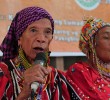By CARLOS H. CONDE
Sunday Inquirer Magazine
September 23, 2001
Even his eyes betrayed him. They looked weary, as though they had not had a wink for days. If you looked into them, you would get the sense that this man had gone through hell. Betrayed is probably the right word, and that is exactly what Nur Misuari has been feeling nowadays.
On this night inside his office in Zamboanga City (his first night outside Jolo, where he spent three weeks in self-imposed seclusion days before the August 14 plebiscite in the Autonomous Region in Muslim Mindanao or ARMM), Misuari sat in a gray leather sofa, wearing a light-blue polo shirt and cream slacks and a pair of slippers that couldn’t hide his longish toenails. He looked pale and the huge picture frame of Mecca behind him – in which tens of thousands of Muslims from all over the world are praying to Allah – did little to brighten his aura.
“I cannot understand how Misuari can become a threat,” he says by way of explaining the unusual troop movement in Jolo when he was there. “I told them (Malaca�ang officials) that if I wanted war, why did I ever agree to sign the peace agreement to end the war? Why? There is no logic to that! But it is they who I believe are so anxious to make war on us, thinking perhaps that the Moro National Liberation Front (MNLF) is already a spent force, that Misuari cannot command any more respect.”
And so it is that the man who brought to the fore the legitimacy of the Moro struggle, the man who swore before his father’s grave that he would take up arms for his people’s liberation, is still fighting for the one thing that has eluded the Moros for decades – respect.
August 14, the day of the plebiscite that sought the expansion of the ARMM, is considered by Misuari as his own Day of Infamy. That plebiscite represented to Misuari what to him is his worst betrayal by the government. The Arroyo administration had proceeded with the plebiscite despite his pleadings, despite his arguments that the plebiscite was a violation of the 1996 Final Peace Agreement that he signed with then president Fidel Ramos.
Misuari had argued that the law that amended the original Organic Act creating the ARMM was not only faulty, it was also unilateral in that the MNLF which Misuari heads was not a party to its crafting. Misuari and the MNLF had campaigned for a boycott of the plebiscite. They said that approving the law would be an injustice to the Moros. By forcing the issue, Misuari says, the government effectively abrogated the 1996 peace agreement. The result of the plebiscite was disastrous, to say the least.
As Misuari had feared, the opposition to the ARMM’s expansion was massive; only two areas out of the 14 cities and 15 provinces that are supposed to be eligible for inclusion in the ARMM voted yes. Any more impressive than that would have been unthinkable, simply because the ARMM, one of the poorest regions in the country, is hardly a showcase of promise, let alone prosperity.
The national government has been blaming Misuari for that, arguing that due to his incompetence, Misuari had squandered the opportunity to make autonomy work. To some degree, this is true. Even Misuari’s sympathizers – like Fr. Eliseo Mercado Jr., a leading Mindanao peace advocate – concede that he is an inefficient manager. That was obvious when he was chosen governor of the ARMM: it took him more than two months to fill up the cabinet positions. It was also clear, thanks to his frequent absence in the ARMM, that he was preoccupied with things other than running the region. In fact, in his first year as ARMM governor and chairman of the Southern Philippines Council for Peace and Development (SPCPD), some of his colleagues in the MNLF Central Committee were already complaining about his frequent trips outside his region.
Misuari would counter that, on the contrary, it is the government which has not kept its end of the bargain. Records would tend to favor Misuari. For example, the budget for the ARMM’s development projects and programs has dwindled in the past years; from a high of P1.5 billion in 1998 (out of the ARMM’s total P4.9 billion budget for that year), the funds for projects dropped to P545 million the next year, then to a measly P50 million for 2002. (Between 80 percent to 85 percent of ARMM’s budget has always been allotted – even before Misuari’s time – to the salaries of the region’s close to 20,000 employees.)
Besides, Misuari simply didn’t stand a chance in making autonomy work. Aside from the fact that the autonomous region is largely dependent on the whims of the national government as far as budget is concerned, the SPCPD is seriously flawed. Under the executive order that created it, the SPCPD is simply mandated to monitor and suggest projects and programs (which are undertaken by national line agencies), not implement these. In a political experiment that has a direct impact on the lives of Moros and on how non-Moros regard them, that meant a whole world of difference. And because the public and the media have been conditioned to accept that growth and prosperity in Mindanao is the SPCPD’s main task, blame for its failure would land on the lap of its chairman. The situation was so flawed some MNLF officials thought it was a setup.
To make matters worse, most investments and development projects in Mindanao were poured into relatively well-off areas such as the Davao provinces, General Santos City, Sarangani province and Zamboanga – areas which leaders tasked by Malaca�ang to promote Mindanao, such as former presidential assistant for Mindanao Paul Dominguez, reportedly have considerable vested interests in. Indeed, the ARMM areas hardly figured in the much-vaunted BIMP-Eaga, which Dominguez zealously pushed during Ramos’ time.
As a result, Misuari had little to show, if at all, to convince people of the viability of autonomy because either he didn’t have the money to do it or whatever projects implemented during his term were not credited to him, let alone to autonomy. Thus, as far as Misuari, some Moros and even Mindanao peace advocates are concerned, the ARMM was doomed to fail from the very start. Misuari, Fr. Mercado says, “was put in a straitjacket.”
Either way, Misuari’s critics are convinced that he just couldn’t hack it as a politician. They are so convinced, in fact, that hardly any blame is being heaped on Malaca�ang, which has direct control and supervision over the SPCPD. As Fr. Mercado puts it, “the SPCPD is directly attached to the Office of the President. They cannot simply wash their hands.”
But blaming Misuari became de rigueur. A top MNLF official told Asiaweek in 1999 that if Misuari “continues to stay in Manila, that’s the end of him. He is isolating himself from the people. People need him. His presence is better than money. Leadership is better than money.” Parouk Hussin, another leader of the so-called Council of 15 that went against Misuari, told the same magazine: “If you are a leader of a revolutionary organization and if you are betraying the trust of the general population, then you are plotting your own ouster.”
That “ouster” came in April 2001, when Hussin and the other members of the Council of 15, “retired” Misuari as chairman of the MNLF, making him instead “chairman emeritus.” A few weeks later, Malaca�ang stripped Misuari of the SPCPD chairmanship. Beaten, Misuari sought refuge in his hometown.
Hussin says they ousted Misuari because “we want to move forward. With Misuari, we are not moving an inch. He’s given enough time (but) what has he done? We have nothing personal against the man. The issue is, shall we allow peace to be held hostage by one man, by his incompetence, by his failure? Whatever his hand touches turns to failure!”
But there are those who believe that Misuari’s “dismal performance” as an administrator was not the main reason for his ouster. After all, says Fr. Mercado, Hussin and Muslimin Sema, the man who replaced Misuari as chairman of the SPCPD, were Misuari’s trusted officials to whom he delegated functions in running the ARMM and the SPCPD. “These are the same people who failed to do their jobs. What assurance do we get that they will perform any better now?” Fr. Mercado asks.
Fr. Mercado thinks that politics is behind Misuari’s ouster, noting that those who ousted Misuari are MNLF officials who also occupy positions in government. Sema, for example, is mayor of Cotabato City while Hussin is the presidential adviser on Muslim Mindanao. “President Arroyo needs to consolidate her people in Mindanao for the year 2004 elections. She needs to put people she thinks can deliver the votes because Mindanao is largely Estrada country,” Fr. Mercado says.
This theory also jibes with the role Norberto Gonzales, Arroyo’s adviser on “special concerns” and also head of the Partido Demokratiko-Sosyalita ng Pilipinas, played in Misuari’s ouster. It was Gonzales who supposedly organized the Council of 15 against Misuari. At present, the PDSP has put up chapters in practically every major province in Muslim Mindanao, with MNLF officials as key leaders. (Ironically, the Jesuit-led PDSP and the MNLF go way back, to the Marcos years, when the PDSP sought refuge with the MNLF in Sabah when the dictator declared martial law.)
Misuari has blamed Gonzales and the PDSP for plotting his ouster, saying that it was the classic divide-and-rule tactic. But Gonzales says Misuari is mistaken. What happened was an internal rift in the MNLF, he says. “I don’t know why he takes it personally. He thinks he is the king of the MNLF,” Gonzales says.
Gonzales concedes that Misuari still commands the respect of the Moro people but his performance, he says, “is really hurting them. We have to do it because the interests of our people are far more important than the interest of Misuari.”
He admits, however, that it is not just Misuari’s fault. “You cannot blame Nur for his failure. Government may have to be blamed for his inability to govern effectively. That is evident,” Gonzales says.
It is conceivable, says a source familiar with the workings of the MNLF, that Misuari could have been talked into making concessions, if – and it’s a big if – the purpose was to implement seriously the peace agreement and if Misuari was indeed a roadblock. But the man simply cannot be disabused of his belief that the failure of autonomy was not his fault, simply because it was not entirely his fault. Faced with this resolve, those who wanted him out of the picture used what Misuari calls treachery instead of diplomacy. And if there is one thing that hurts Misuari most, it is betrayal.
The Tausugs, who are the descendants of the Sulu sultanate, are considered a very proud people. Misuari is no different. “How you approach the man is essential,” says Fr. Mercado. “People may be a little wary talking to him (because of his stature in the Moro community) but I find him open and reasonable,” he says. “The government shouldn’t have ousted him through the council. They could have come up with an acceptable agreement. The last thing you do is stab him in the back.”
Ibno Husien, a 36-year-old Moro who has been with the MNLF since his college days and who now acts as caretaker of the ARMM’s office in Cabatangan, Zamboanga City, agrees. “Ma’as is a very simple man. He does not have a wallet, does not carry around money. He hasn’t even bought a replacement for a watch given to him as a gift by a Korean friend years ago. Why they are doing this is beyond me. This is no reason to betray him,” Husien says in broken Tagalog. (Ma’as is a Tausug word that means “old man” and is usually used to address somebody who is revered.)
This betrayal is what hurts Misuari the most. “The government betrayed us. It has never unlearned its treacherous tendencies. We thought when the government betrayed us during the time of Marcos, that it was enough. Then it was repeated during the time of Aquino. Again and again and again. And I tell you this is probably the worst betrayal, under the regime of Arroyo,” he says.
Despite that, Misuari says he continues to hope that things will turn out all right. In fact, all is not lost, according to him, because if there’s one good thing that has happened since 1996, it is that the alleged abrogation by the government of the peace agreement “finally crystallized one thing: that indeed the government is not that interested in hearing us out. I never regretted anything. As a matter of fact, we need this crystallization so we won’t be mesmerized again by their false promises.”
Many people, particularly those in the Council of 15 and the PDSP, believe that Misuari is finished politically. The government, however, is sending a different signal. Through House Speaker Jose de Venecia, Malaca�ang has been trying to court back Misuari, even offering him an ambassadorial position of his choice. Misuari has so far refused to take the bait. Is this offer part of the strategy to mollify him? “I am not a child to be treated that way,” Misuari replies.
It’s definitely not the end of Misuari. “Well, they have been predicting the end of Misuari 101 times. But every time, they see Misuari is still very much alive and kicking. I am more alive than ever before.”
He still commands considerable following in the MNLF, whose young members last April declared, albeit unofficially, a reversion to the MNLF’s original position (a separate Islamic state) by calling for the secession of what it called the Bangsa Moro Republik with Misuari as president. Misuari himself declares that “we are back on square one.”
The hills, however, are farthest from his mind right now. After emerging from his seclusion in Jolo, Misuari went to see his children in the Middle East, where they are studying. Misuari has nine children by two of his four wives (one of whom, Desdemona, died in 1987).� The youngest is a 14-year-old girl, who, upon hearing a radio broadcast once that severely criticized her father, remarked: “Father, you better go to war.” Misuari says he just smiled at her and said: “You don’t understand what war is like.”
Misuari says he takes pity on his children “for having been born into this kind of chaotic situation. But I think they can put up with it.” As to the wives, he says, “They’re used to this.”
Misuari, 61, has been asked by the University of Berkeley to write a book on his and the MNLF’s experiences, but he told them not yet. He would love to go back to his “first love,” teaching, but that can wait for the right time, he says. “Of course, even when I’m outside the university, I continue teaching people about our experiences and our struggle,” says the former University of the Philippines professor. (This love affair with teaching was cut short, however, by the Jabidah Massacre in 1968, which forced Misuari to take up arms against the government. “Up to now,” he says, “the specter of that massacre is very much alive.”)
He says he is not bothered by what history will say about him. “My only concern is that I be able to fulfill my pledges to my people. I want them to have a good life. I want to enhance the quality of life of my people. I want to see them free, as free as any people in the world. I want to stop their oppression, exploitation and repression. We want our children to grow healthy and in an atmosphere of freedom, without fear and intimidation. This is my commitment to our people. And I hope some people will not begrudge us for doing something to achieve that.” (davaotoday.com)










